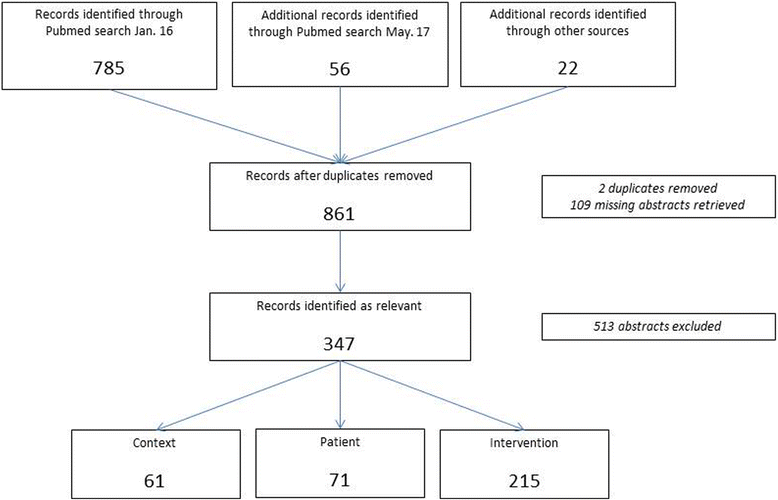Clinical decision making in cancer care: a review of current and future roles of patient age
- PMID: 29743048
- PMCID: PMC5944161
- DOI: 10.1186/s12885-018-4456-9
Clinical decision making in cancer care: a review of current and future roles of patient age
Abstract
Background: Patient age is among the most controversial patient characteristics in clinical decision making. In personalized cancer medicine it is important to understand how individual characteristics do affect practice and how to appropriately incorporate such factors into decision making. Some argue that using age in decision making is unethical, and how patient age should guide cancer care is unsettled. This article provides an overview of the use of age in clinical decision making and discusses how age can be relevant in the context of personalized medicine.
Methods: We conducted a scoping review, searching Pubmed for English references published between 1985 and May 2017. References concerning cancer, with patients above the age of 18 and that discussed age in relation to diagnostic or treatment decisions were included. References that were non-medical or concerning patients below the age of 18, and references that were case reports, ongoing studies or opinion pieces were excluded. Additional references were collected through snowballing and from selected reports, guidelines and articles.
Results: Three hundred and forty-seven relevant references were identified. Patient age can have many and diverse roles in clinical decision making: Contextual roles linked to access (age influences how fast patients are referred to specialized care) and incidence (association between increasing age and increasing incidence rates for cancer); patient-relevant roles linked to physiology (age-related changes in drug metabolism) and comorbidity (association between increasing age and increasing number of comorbidities); and roles related to interventions, such as treatment (older patients receive substandard care) and outcome (survival varies by age).
Conclusions: Patient age is integrated into cancer care decision making in a range of ways that makes it difficult to claim age-neutrality. Acknowledging this and being more transparent about the use of age in decision making are likely to promote better clinical decisions, irrespective of one's normative viewpoint. This overview also provides a starting point for future discussions on the appropriate role of age in cancer care decision making, which we see as crucial for harnessing the full potential of personalized medicine.
Keywords: Age; Age factors; Clinical practice; Decision making; Oncology; Personalized medicine; Priority setting.
Conflict of interest statement
Ethics approval
Not applicable.
Competing interests
The authors declare that they have no competing interests.
Publisher’s Note
Springer Nature remains neutral with regard to jurisdictional claims in published maps and institutional affiliations.
Figures
Similar articles
-
Context factors in clinical decision-making: a scoping review.BMC Med Inform Decis Mak. 2025 Mar 17;25(1):133. doi: 10.1186/s12911-025-02965-1. BMC Med Inform Decis Mak. 2025. PMID: 40098142 Free PMC article.
-
What factors hinder the decision-making process for women with cancer and contemplating fertility preservation treatment?Hum Reprod Update. 2017 Jul 1;23(4):433-457. doi: 10.1093/humupd/dmx009. Hum Reprod Update. 2017. PMID: 28510760 Review.
-
[Geriatric assessment and prognostic scores in older cancer patient: Additional support to the therapeutic decision?].Bull Cancer. 2017 Nov;104(11):946-955. doi: 10.1016/j.bulcan.2017.10.004. Epub 2017 Nov 14. Bull Cancer. 2017. PMID: 29150094 Review. French.
-
Self-management priority setting and decision-making in adults with multimorbidity: a narrative review of literature.Int J Nurs Stud. 2015 Mar;52(3):744-55. doi: 10.1016/j.ijnurstu.2014.10.010. Epub 2014 Oct 28. Int J Nurs Stud. 2015. PMID: 25468131 Free PMC article. Review.
-
Predictors of Treatment Decisions in Multidisciplinary Oncology Meetings: A Quantitative Observational Study.Ann Surg Oncol. 2016 Dec;23(13):4410-4417. doi: 10.1245/s10434-016-5347-4. Epub 2016 Jul 5. Ann Surg Oncol. 2016. PMID: 27380047
Cited by
-
Geriatric Communication Skills Training Program for Oncology Healthcare Providers: a Secondary Analysis of Patient and Caregiver Outcomes.J Cancer Educ. 2024 Feb;39(1):12-17. doi: 10.1007/s13187-023-02367-9. Epub 2023 Sep 7. J Cancer Educ. 2024. PMID: 37676422 Free PMC article.
-
How aging of the global population is changing oncology.Ecancermedicalscience. 2021 Dec 13;15:ed119. doi: 10.3332/ecancer.2021.ed119. eCollection 2021. Ecancermedicalscience. 2021. PMID: 35211208 Free PMC article.
-
A comprehensive review on immune checkpoint inhibitors induced cardiotoxicity characteristics and associated factors.Eur J Med Res. 2023 Nov 8;28(1):495. doi: 10.1186/s40001-023-01464-1. Eur J Med Res. 2023. PMID: 37941006 Free PMC article. Review.
-
All-Cause Mortality Risk Prediction in Older Adults with Cancer: Practical Approaches and Limitations.Curr Oncol Rep. 2022 Nov;24(11):1377-1385. doi: 10.1007/s11912-022-01303-2. Epub 2022 Jun 1. Curr Oncol Rep. 2022. PMID: 35648341 Review.
-
Precision medicine and the principle of equal treatment: a conjoint analysis.BMC Med Ethics. 2021 May 10;22(1):55. doi: 10.1186/s12910-021-00625-3. BMC Med Ethics. 2021. PMID: 33971875 Free PMC article.
References
-
- National Cancer Equality Initiative . The impact of patient age on decision making in oncology. London: Department of Health; 2012.
Publication types
MeSH terms
LinkOut - more resources
Full Text Sources
Other Literature Sources


